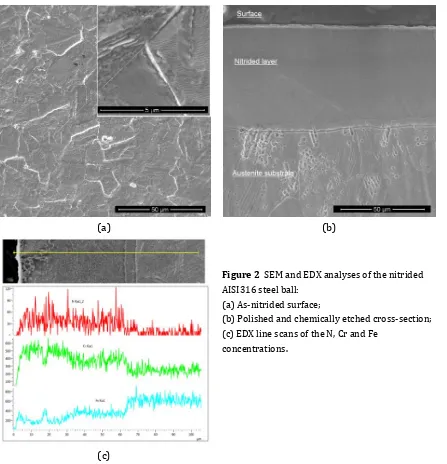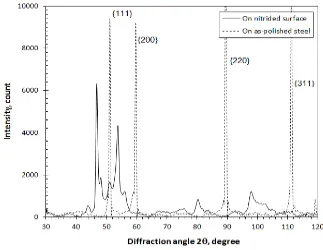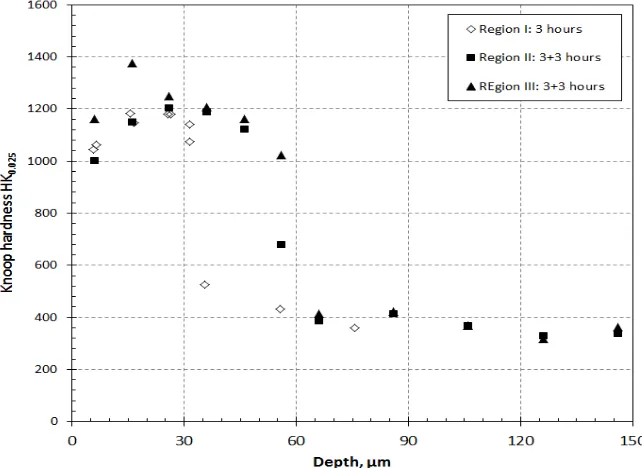YANG, Shicai, LUO, Quanshun <http://orcid.org/0000-0003-4102-2129>,
SUN, Hailing, KITCHEN, Matthew and COOKE, Kevin
Available from Sheffield Hallam University Research Archive (SHURA) at:
http://shura.shu.ac.uk/14131/
This document is the author deposited version. You are advised to consult the
publisher's version if you wish to cite from it.
Published version
YANG, Shicai, LUO, Quanshun, SUN, Hailing, KITCHEN, Matthew and COOKE,
Kevin (2016). Physical and tribological properties of Nitrided AISI 316 stainless steel
balls. MATEC Web of Conferences, 77, 01037.
Copyright and re-use policy
See
http://shura.shu.ac.uk/information.html
Sheffield Hallam University Research Archive
1
Physical and Tribological Properties of Nitrided AISI
316 Stainless Steel Balls
S. Yang
1, Q. Luo
2, H. Sun
1, M. Kitchen
2, K. Cooke
11
Teer Coatings Ltd., Miba Coating Group, West Stone House, Berry Hill Industrial
Estate, Droitwich, WR9 9AS, UK
2
Materials and Engineering Research Institute, Sheffield Hallam University, Howard
Street, Sheffield S1 1WB, UK
Dr Shicai Yang: shicai.yang@miba.com Dr Quanshun Luo: q.luo@shu.ac.uk
Published in: MATEC Web of Conferences 77, 01037 (2016), ICMMR 2016 [DOI: 10.1051/matecconf/20167701037]
Presented in: 2nd International conference on tribology and interface engineering (ICTIE2016),
Chongqing, China, June 15-17, 2016.
2
1 INTRODUCTION
Austenitic stainless steels are known to have outstanding toughness, biomedical compatibility, corrosion resistance and oxidation resistance [1, 2], and therefore have been widely used in industries, such as food [3], biomedical devices [4-6], petroleum and chemical engineering [7], steam turbines [2], and nuclear energy generation [8]. A recent review of the composition, microstructure and functions of stainless steels can be found in Ref. [9]. The major weakness of austenitic stainless steels is their low hardness [10], typically 150 – 250 HV, which limits the wear resistance of components such as ball bearings. The surface hardness of stainless steel can be enhanced significantly to 1000 HV by means of nitriding treatments in a gaseous or plasma medium [11, 12]. These enable the production of piston rings and gears with outstanding tribological properties. Moreover, surface nitrided stainless steel could also find applications in ball bearings to be used at elevated temperatures owing to the material’s combined high surface hardness and excellent oxidation resistance. To date, however, little research has been published on the plasma nitriding of austenitic stainless steel balls. One factor may be the complexity involved in supporting multiple balls while achieving an effective plasma treatment, and to provide uniform nitriding over the entire ball surface.
In this paper, we report recent research on the characterization and tribological evaluation of plasma nitrided balls made from austenitic stainless steel AISI 316, to explore its feasibility for ball bearing applications.
2 Experimental
Austenitic stainless steel AISI 316 was employed in the research, including balls of both 5 mm and 12 mm in diameter and square flat samples of 20×20×2.0 mm in size. The balls were manufactured with a grade 10 surface finish and the flat samples were manually polished with 1200# SiC abrasive paper, all samples being ultrasonically cleaned in acetone and dried before plasma treatment.
[image:3.595.128.469.521.722.2]3 The nitriding treatment was completed using an industrial pulsed DC glow discharge plasma process [13], at input power 2.5 kW, pulse frequency 360 kHz and potential -550 V The gaseous medium in the nitriding chamber was controlled at a pressure of 1.33 Pa and with an Ar/N2 flow ratio of 1:3. The nitriding process was controlled in a range 450–500 C. In the nitriding chamber, each ball was supported with a specially made jig to ensure effective exposure to the nitriding atmosphere for most of the spherical surface, except a small area hidden by the jig, Fig. 1. After the first 3-hour nitriding process, the chamber was vented to atmosphere and each ball was turned by an angular rotation sufficient to allow the hidden area to be nitrided in a second 3-hour nitriding process.
The nitriding treatment was completed using an industrial pulsed DC glow discharge plasma process [13], at input power 2.5 kW, pulse frequency 360 kHz and potential -550 V The gaseous medium in the nitriding chamber was controlled at a pressure of 1.33 Pa and with an Ar/N2 flow ratio of 1:3. The nitriding process was controlled in a range 450–500 C.In the nitriding chamber, each ball was supported with a specially made jig to ensure effective exposure to the nitriding atmosphere for most of the spherical surface, except a small area hidden by the jig, Fig. 1. After the first 3-hour nitriding process, the chamber was vented to atmosphere and each ball was turned by an angular rotation sufficient to allow the hidden area to be nitrided in a second 3-hour nitriding process.
A field emission SEM, FEI Nova-200 FEG-SEM, was employed to analyse the as-nitrided surfaces and cross-sectional microstructure. For the latter, cross-sectioned samples were ground and polished to mirror finish before chemical etching in a Kailling’s No. 2 solution. Energy dispersive X-ray (EDX) spectroscopic chemical analysis was also applied along with the SEM observation. A Philips X'Pert X-ray diffractometer with radiation Cu-Kα1 (λ = 0.154056 nm, at power of 40 kV and 40 mA) was employed to analyse the crystallographic properties.
The hardness properties were measured using two methods, namely, Vickers hardness of the nitrided surfaces at a load of 0.3 kg and Knoop hardness profile on polished cross-sections at an indenting load of 0.025 kg. The depth of the nitrided layers was measured on polished cross-sections using both SEM and optical microscopy.
Pin-on-disk sliding wear tests were carried using two configurations by using the nitrided ball samples and hardened Cr-steel balls with hardened and ground M42 tool steel flat samples as the counterpart. The wear tests were conducted at a constant applied normal load of 5 N and linear sliding speed of 0.2 ms-1. Each test ran for 60 minutes, before the ball and flat samples were taken off to measure the wear volumes.
3 Results and discussion
3.1Microstructural characterization
4 Fig. 2c is the line-scan profiles of the characteristic X-rays N-K, Cr-K and Fe-K, to show the variation of N, Fe and Cr concentrations in the nitrided layer. The line-scans indicate a distinct profile of nitrogen in the nitrided layer, along with enriched Cr and reduced Fe concentration in comparison to the austenite substrate, which supports the Cr-trapping nitriding mechanism [9]. Meanwhile, EDX analysis also reveals the chemical compositions of the nitrided layer (acquired on the sample surface), in Table 1. Note that the N concentration is double that of the Cr concentration, indicating highly supersaturated nitrogen.
(a) (b)
(c)
Figure 2 SEM and EDX analyses of the nitrided AISI316 steel ball:
(a) As-nitrided surface;
(b) Polished and chemically etched cross-section; (c) EDX line scans of the N, Cr and Fe
[image:5.595.305.518.187.421.2]concentrations.
Table 1 Chemical composition of nitrided surface determined by SEM-EDX.
N Cr Mo Fe Ni Si Mn
at% 26.77 13.77 0.87 48.68 8.03 0.84 1.05
[image:5.595.158.436.685.748.2]5 Fig. 3 shows X-ray diffraction curves of the nitrided and as-polished samples. The nitrided sample shows strong diffraction peaks of both the {111} and {200} planes as evidence of a substantially expanded austenite lattice (also called the S-phase [6, 9, 11]). In addition, several low-intensity diffraction peaks suggest precipitation of Cr- and or Fe-nitride phases.
Figure 3. X-ray diffraction curves of nitrided and as-polished 316 steel samples.
3.2 Thickness, hardness property and thermal stability
To evaluate the thickness profile of the nitrided balls, a ball was sectioned diametrically across the region of the jig-obscured circle, and subsequently mounted, ground and polished. The nitrided layer depth was measured at equal intervals of around 1 mm with a total of 22 readings between the minimum 46.43 m and the maximum 59.03 m, leading to a statistical average of 54.25 ~ 3.29 m. The measurements indicate a relatively uniform thickness distribution throughout the ball surface, whereas the jig-obscured area shows a reduced layer thickness of 39.73 ~ 2.25 m.
Fig. 4 shows hardness profiles across the whole nitrided depth. The nitrided layer exhibits high hardness of HK0.025 1100-1200. It also shows that, the double 3-hour nitriding process brought about only a marginal further increase in the hardness.
6 hardness of the 700 C annealed sample was significantly reduced. Nevertheless, the nitrided 316 steel exhibited superior thermal stability when compared to hardened 100Cr6 ball bearing steel, which implies its potential suitability for bearing components to be used at elevated temperatures.
[image:7.595.145.453.463.633.2]Figure 4. Microhardness depth profiles of as-nitrided ball.
Table 2 Wear depth (d) and specific wear rate (k) of the tested samples
balls dball (µm) kball (m 3
/Nm) kdisc (m 3
/Nm)
At 5 N, run for 60 minutes
N-ASS 37.2 3.1×10-15 4.3×10-16
Cr-Steel 78.2 1.4×10-14 2.6×10-16
At 5 N, run for 30 minutes
N-ASS 23.7 2.5×10-15 6.2×10-16
Cr-Steel 52.6 1.2×10-14 4.2×10-16
At 2 N, run for 60 minutes
N-ASS 19.2 2.0×10-15 1.1×10-15
Cr-Steel 66.2 2.4×10-14 6.1×10-16
3.3 Wear and friction properties
Details of the wear properties are summarized in Table 2. The 100Cr steel exhibited 12 times higher wear rate than the nitrided 316 steel when the applied load was 2 N. When the load was 5 N, the two “as received” materials’ wear rates were more similar whereas the wear of the nitrided 316 was still four times lower.
7 when the nitrided layer was worn through resulting in wear of the substrate. The sliding time was then reduced to 30 minutes to ensure that wear was limited to within the nitrided depth. Regardless of the applied loads and sliding distances, both the nitrided 316 and hardened 100Cr6 steels exhibited high friction coefficients, which could be explained by the adhesive steel-to-steel contact which occurred without the presence of lubrication.
Figure 5. Effect of annealing temperature on the hardness property of nitrided 316 steel and hardened 100Cr steel.
[image:8.595.135.451.463.704.2]8 Figure 7 Friction corves of the tested samples.
(a)
(b)
Figure 8. (a) Low magnification images of ball wear scars of nitrided 316 steel and hardened
100Cr steel; (b) A high magnification SEM image of the worn surface of the nitrided 316
[image:9.595.84.474.348.769.2]9 Fig. 8a shows low-magnification images of the resulting wear scars. The wear rates of the nitrided 316 and 100Cr were dramatically different. Fig. 8b is the worn surface observed by SEM at high magnification, taken in the region of worn scar on nitrided ball after 60-minute and 5-N test. The SEM observation indicates that the rubbed nitrided ball surface exhibits typical sliding wear mechanisms of grooving deformation. Such wear is normally caused by hard abrasive particles. In this case, it is believed that the un-dissolved carbide particles in the high-alloy M42 tool steel should have played the role of hard abrasives, causing abrasive wear. When such wear mechanism dominates the sliding wear process, the wear rate decreases with the increase of hardness of the tested material, which can explain the striking difference between the wear rates of the nitrided 316 steel and the hardened 100Cr6. Fig. 9 shows the wear measurements of the counterpart M42 tool steel disks.
Figure 9. Low magnification images of the ball-crater measurements on wear tracks of the counterpart M42 steel disks.
The dramatically increased wear resistance of the nitrided 316 steel can be related to its increased hardness and hence increased resistance to abrasive wear and plastic deformation, and also by its enhanced thermal stability which helped to prevent softening due to the frictional heating. Further detailed investigation of the worn surfaces, e.g. by SEM examination, will be carried out later.
10 would be interesting to study the rolling tribology performance of the N-ASS balls but this will need to be addressed in further research.
4 Conclusions
Nitrided AISI 316 austenitic stainless steel balls were characterized as having high hardness, high capability to withstand stress and high sliding wear resistance and outperformed hardened Cr-Steel balls and hardened M42 steel discs under the identical pi-on-disc testing.
Up to a maximum hardness of HV0.3 1000 can be retained on the nitrided AISI 316 austenitic stainless steel balls at temperatures up to 400 C, whereas in comparison the hardness of hardened Cr-Steel balls was reduced from the HV0.3 650 of the original to HV0.3 350 after heat treated.
All the results indicated that AISI 316 austenitic stainless steel balls were significantly improved in their tribological properties after nitriding suggesting the potential applicability of these nitrided austenitic stainless steel balls in the ball bearing industry.
REFERENCES
[1] C. Allen, A, ball, Wear 74, 287-3905 (1981-1982).
[2] P. J.Maziasz, B. A. Pint, J. P.Shingledecker, K. L. More, N. D. Evans, E. Lara-Curzio, Proceedings of ASME Turbo Expo (2004) 2.
[3] S. Cvetkovski, M. Matyer. Eng. 18, 283-293 (2012).
[4] K. Bordjih, E. Y. Jouzeau, D. Mainard, E. Payan, J. P. Delagoutte, P. Netter, Biomaterials 17, 491-500 (1996).
[5] T. Newson, Stainless steels for hygienic applications, BSSA Conference-Stainless solutions for a sustainable future. Magna Science Advanture Centre, Sheffield (2003).
[6] J. Buhagiar, T. Bell, R. Sammons, H. S. DongS. J Mater Sci 22, 1268-1278 (2011). [7] R.D. Kane, M.S. Cayard, Corrosion 98, 1-28(1998).
[8] S. Baindur, Bulletin of the Canadian Nuclear Society 29, 32-38(2008). [9] Q. Luo, S. Yang, Int. J. Nanomed Nanosurg 1.1, 1–10(2015).
[10] E. T. Akinlabi, S, A. Akinlabi, Int J. Mechanical, Aerospace, Industrial, Mechatronic, and Manufacturing Engineering 8, 256-261 (2014).
[11] Y. Sun, T. Bell, Wear 218, 34 (1998).
[12] V. Toshkov, R. Russev, T. Madjarov, E. Russeva, J. Achiev. Mater. Manuf. Eng. 25, 71-74 (2007).






